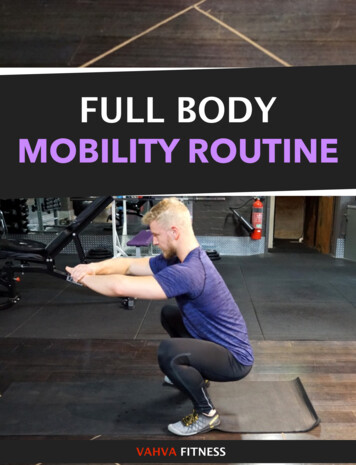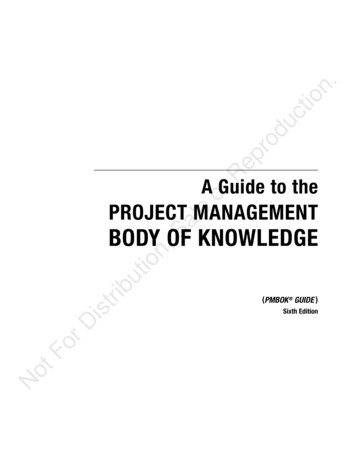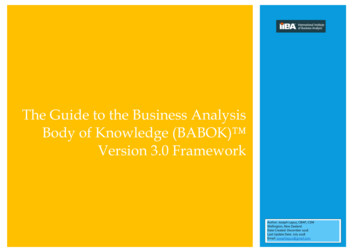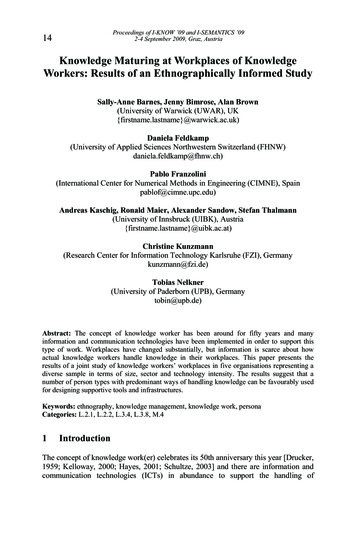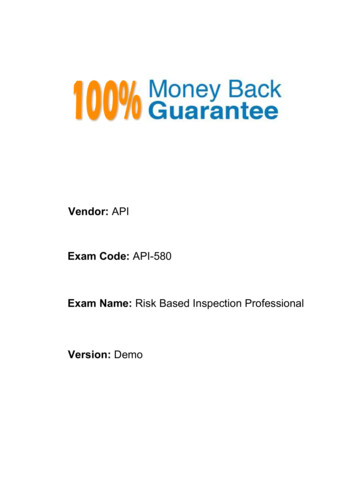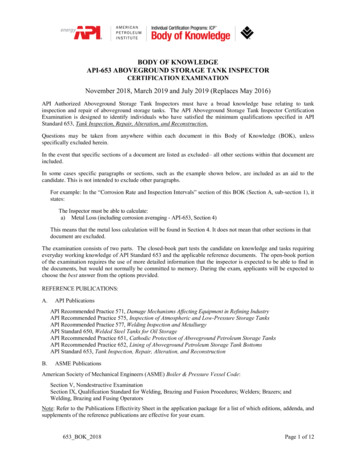
Transcription
BODY OF KNOWLEDGEAPI-653 ABOVEGROUND STORAGE TANK INSPECTORCERTIFICATION EXAMINATIONNovember 2018, March 2019 and July 2019 (Replaces May 2016)API Authorized Aboveground Storage Tank Inspectors must have a broad knowledge base relating to tankinspection and repair of aboveground storage tanks. The API Aboveground Storage Tank Inspector CertificationExamination is designed to identify individuals who have satisfied the minimum qualifications specified in APIStandard 653, Tank Inspection, Repair, Alteration, and Reconstruction.Questions may be taken from anywhere within each document in this Body of Knowledge (BOK), unlessspecifically excluded herein.In the event that specific sections of a document are listed as excluded– all other sections within that document areincluded.In some cases specific paragraphs or sections, such as the example shown below, are included as an aid to thecandidate. This is not intended to exclude other paragraphs.For example: In the “Corrosion Rate and Inspection Intervals” section of this BOK (Section A, sub-section 1), itstates:The Inspector must be able to calculate:a) Metal Loss (including corrosion averaging - API-653, Section 4)This means that the metal loss calculation will be found in Section 4. It does not mean that other sections in thatdocument are excluded.The examination consists of two parts. The closed-book part tests the candidate on knowledge and tasks requiringeveryday working knowledge of API Standard 653 and the applicable reference documents. The open-book portionof the examination requires the use of more detailed information that the inspector is expected to be able to find inthe documents, but would not normally be committed to memory. During the exam, applicants will be expected tochoose the best answer from the options provided.REFERENCE PUBLICATIONS:A.API PublicationsAPI Recommended Practice 571, Damage Mechanisms Affecting Equipment in Refining IndustryAPI Recommended Practice 575, Inspection of Atmospheric and Low-Pressure Storage TanksAPI Recommended Practice 577, Welding Inspection and MetallurgyAPI Standard 650, Welded Steel Tanks for Oil StorageAPI Recommended Practice 651, Cathodic Protection of Aboveground Petroleum Storage TanksAPI Recommended Practice 652, Lining of Aboveground Petroleum Storage Tank BottomsAPI Standard 653, Tank Inspection, Repair, Alteration, and ReconstructionB.ASME PublicationsAmerican Society of Mechanical Engineers (ASME) Boiler & Pressure Vessel Code:Section V, Nondestructive ExaminationSection IX, Qualification Standard for Welding, Brazing and Fusion Procedures; Welders; Brazers; andWelding, Brazing and Fusing OperatorsNote: Refer to the Publications Effectivity Sheet in the application package for a list of which editions, addenda, andsupplements of the reference publications are effective for your exam.653 BOK 2018Page 1 of 12
CALCULATIONS & TABULAR EVALUATIONS FOR EVALUATING THICKNESS MEASUREMENTS,WELD SIZES, AND TANK INTEGRITY(NOTE: Paragraph references for all formulas and calculations listed here should be checked for accuracy to theedition, addenda, or supplement for the examination you plan to take per the Publication Effectivity Sheet in the APIExamination Application.)NOTE: Candidates are expected to be able to understand SI units (metric system) and the US customary units (inches,feet, PSI, etc.) and to use both system formulas.A. Calculation questions will be oriented toward existing tanks, not new tanks. API Authorized AST Inspectorsshould be able to check and perform calculations included in the following categories:1.CORROSION RATES AND INSPECTION INTERVALS (API-575, Paragraph 7.2)The Inspector should be able to take inspection data and determine the internal and external inspection intervals.These calculations could be in either the “open book” or “closed book” portion of the exam. The Inspector must beable to calculate:a)b)c)d)e)Metal Loss (including corrosion averaging – (API-653, Section 4)Corrosion RatesRemaining LifeRemaining Corrosion AllowanceInspection Interval (API-653, Section 6)Remaining life (years) t actual - t minimumcorrosion rate[inches (millimeters) per year]Where:t actual t minimum the thickness, in inches (millimeters), recorded at the time ofinspection for a given location or component.minimum allowable thickness, in inches (millimeters), for agiven location or component.Corrosion rate t previous t previous - t actualyears between t actual and t previousthe thickness, in inches (millimeters), recorded at the samelocation as t actual measured during a previous inspection.The formulas for performing the above calculations and rules for setting the inspection intervals may be "closedbook" during the exam. The inspector should also be able to compensate for the corrosion allowance. (Add orsubtract based on requirements from the exam problem.)2.JOINT EFFICIENCIESThe inspector must be able to determine the joint efficiency, "E", of a tank weld. Inspector should be able todetermine:a) Joint Types (API-653 Section 4, Table 4-2)b) Type and extent of radiography performed (API 653, Table 4-2, Section 12; API 650, Section 8.1, Figure 81)c) Joint efficiency by reading API-653, Table 4-2653 BOK 2018Page 2 of 12
Determining joint efficiency may be part of a minimum thickness or maximum fill height problem since jointefficiency, "E", is used in the formulas for determining required thickness. (API-653, 4.3.3.1)3.MAXIMUM FILL HEIGHT (HYDROSTATIC TESTING)The inspector should be able to determine the maximum liquid height for a tank. To determine the height, the “t min”formula in API-653 is rearranged as follows. This formula will be provided in the exam. The inspector is NOTexpected to derive this formula by using transposition.a)Calculate the minimum allowable thickness per Section 4 of API 653 or the maximum fill height in thelocalized corroded area per: S E t min H 2.6 D G b) Calculate the minimum allowable thickness per Section 4 of API 653 or the maximum fill height for anentire shell course per: S E t min H 1 2.6 D G 4.WELD SIZES FOR SHELL & ROOF OPENINGSThe inspector should be familiar with determining the sizes and spacing of welds for shell openings to the extent ofbeing able to use the information in the following Figures and Tables:a) API-650, Figures 5-7a, 5-7b, 5-8, 5-9, 5-12, 5-14, 5-16, 5-17, 5-19, 5-20, 5-21b) API-650, Tables 5-6, 5-7, 5-9c) API-653, Figures 9-1, 9-2, 9-4, 9-55.HOT TAPPINGa) The Inspector should be familiar with the Hot Tapping requirements. (API-653, Paragraph 9.14)b) The inspector should be able to calculate the minimum spacing between an existing nozzle and a new hot tapnozzle. (API-653 Paragraph 9.14.3)6.SETTLEMENT EVALUATIONThe Inspector should be able to calculate the maximum allowed settlement for the following:a) Edge Settlement (API-653 Annex B.2.3, fig. B-5)b) Bottom Settlement Near the Tank Shell (API-653, Annex B.2.4, Figures B-6, B-7, B-9 B-10, B-11, B-12, B13)c) Localized Bottom Settlement Remote from the Tank Shell (API-653, Annex B.2.5, Fig. B-8)7.NUMBER OF SETTLEMENT POINTSa)The inspector should be able to calculate the number of survey points for determining tank settlement. (API653 12.5.2, Annex B, Figure B-1, Figure B-2)653 BOK 2018Page 3 of 12
8.IMPACT TESTINGThe inspector should understand the importance of tank materials having adequate toughness. The inspector shouldbe able to determine:a)b)c)d)9.Tank design metal temperature (API-650, 4.2.9.3 & Figure 4-2)Material Group Number for a plate (API-650, Tables 4-3a and 4-3b)If impact testing is required (API-650, Figure 4-1a and 4-1b)If impact test values are acceptable (API-650, Table 4-4a and 4-4b)EXISTING TANK SHELL - MINIMUM THICKNESSa)b)c)d)e)Calculate “S”, allowable stress (API-653, 4.3.3.1 & 4.3.4.1)Determine “E”, Joint efficiency (API-653, 4.3.3.1, 4.3.4.1 & Tables 4-2 & 4-3)Determine “H”, liquid height (API-653, 4.3.3.1 & 4.3.4.1)Calculate- minimum acceptable thickness (API-653, 4.3.3.1 & 4.3.4.1)Calculate the thickness required for continued service (API-653, 4.3.3.1 & 4.3.4.1)10. RECONSTRUCTED TANK SHELL - MINIMUM THICKNESSThe inspector should be able to determine the minimum thickness of the shell of a reconstructed tank. The inspectorshould be able to:a)b)c)d)Determine “Sd”, allowable stress for design condition (API-650, table 5-2, API-653, 8.4.2)Determine “St”, allowable stress for hydrostatic test condition (API-650, Table 5-2, API-653, 8.4.3)Calculate “td”, design shell thickness (API-650, 5.6.3.2, for tanks of 200 foot diameter and smaller)Calculate “tt”, hydrostatic test shell thickness (API-650, 5.6.3.2)11. TANK SHELL - CORRODED AREAThe inspector should be able to determine if a tank shell corroded area is acceptable for continued service. Theinspector should be able to:a)b)c)d)e)Select “t2”, minimum thickness exclusive of pits for a corroded area (API-653, 4.3.2.1.a & Figure 4-1)Calculate “L”, critical length for a corroded area (API-653, 4.3.2.1.b & Figure 4-1)Determine “t1”, average thickness for a corroded area (API-653, 4.3.2.1.c, 4.3.2.1.d, Figure 4-1)Determine “t min” for the corroded area “H”, height and “E”, joint efficiency will be based on corroded area(API-653, 4.3.3.1)Determine if tmin is acceptable (API-653, 4.3.3.1.a & .b)12. TANK SHELL - PITTINGThe inspector should be able to evaluate a pitted area. The inspector should be able to:a) Calculate maximum acceptable pit depth (API-653, 4.3.2.2.a)b) Determine the maximum length of pits in any 8” vertical length (API-653, 4.3.2.2.b & Figure 4-2)13. BOTTOM PLATE MINIMUM THICKNESSThe inspector should be able to determine if the bottom thickness is acceptable for continued service. The inspectorshould be able to:Calculate “MRT”, minimum remaining thickness at the next inspection. (API-653, 4.4.5.1)653 BOK 2018Page 4 of 12
Calculate “O”, maximum period of operation. These formulas will be provided in the exam.14. REPLACEMENT PLATESa)The inspector should be able to determine the minimum dimensions for a replacement plate. (API-653,Figure 9-1)15. LAP WELDED PATCH PLATESPer API-653, Paragraph 9.3 the inspector should be able to determine:a) The minimum thicknessb) The minimum weld sizec) The allowable size of the patch plateB. Typical code calculations and requirements that candidates will NOT be expected to know for purposes of thecertification examination.1.2.3.4.5.6.7.8.Required thickness calculations for wind, earthquake, and small internal pressures;Nozzle calculations for external loads;Flange calculations;Brazing requirements;Calculating venting requirements;Ladder, stairway, and other structural type calculations;Calculations for bottoms supported by grillage;Variable point method calculations653 BOK 2018Page 5 of 12
II. WELDING ON ATMOSPHERIC ABOVEGROUND STORAGE TANKSASME Section IX, Welding and Brazing Qualifications(NOTE: Candidates should be familiar with the basic requirements for welding qualifications for procedures andwelding personnel contained in ASME Section IX. Brazing is NOT covered on the examination. )A. The inspector should have the knowledge and skills required to review a Procedure Qualification Record,Welding Procedure Specification and Welder Performance Qualification.B.a) Determine if procedure and qualification records are in compliance with applicable ASME Boiler andPressure Vessel Code and any additional requirements of API- 653.The weld procedure review will include: Weld Procedure Specification (WPS) Procedure Qualification Record (PQR) Welder Performance Qualification (WPQ)b) Determine if all required essential and non-essential variables have been properly addressed. (Supplementalessential variables will not be a part of the WPS/PQR)c) Determine that the number and type of mechanical tests that are listed on PQR are the proper tests, andwhether the results are acceptable.d) Determine that the welder is qualified to make a production weld according to the WPSWELD PROCEDURE REVIEW WILL ONLY INCLUDE SMAW OR SAW, WITH THE FOLLOWINGLIMITATIONS:a)No more than one process will be included on a single WPS,PQR or WPQ and the WPS to bereviewed will be supported by a single PQR.b) Filler metals will be limited to one-per-process for SMAW or SAWc) The PQR will be the supporting PQR for the WPS.d) The WPQ test coupon is to be welded in accordance with a qualified WPS.e) Base metals will be limited to P1.The following are specifically excluded:1) Dissimilar base metal joints2) Supplemental powdered filler metals and consumable inserts3) Special weld processes such as corrosion-resistant weld metal overlay, hard-facing overlay, and dissimilarmetal welds with buttering4) Charpy impact requirements and supplementary essential variables5) Any PQR and WPS included on the examination will not include heat treatment requirements.C. The inspector should know that the WPS must reference the applicable PQR and that the PQR must be signed anddated.API-650 and API-653: General welding requirements:1.2.API Standard 650, Welded Steel Tanks for Oil Storage: The inspector should be familiar with andunderstand the general rules for welding in API-650, Section 9 and other rules for welding in API-650 suchas those for:a) typical joints and definitionsb) weld sizesc) restrictions on jointsd) maximum allowable reinforcemente) inspection requirementsAPI Standard 653, Tank Inspection, Repair, Alteration, and Reconstruction: The inspector should befamiliar with and understand the general rules for welding in API-653, Section 11.653 BOK 2018Page 6 of 12
III. NONDESTRUCTIVE EXAMINATIONASME Section V, Nondestructive ExaminationNOTE: The examination will cover only the main body of each referenced Article, except as noted:A. Article 1, General Requirements:The inspector should be familiar with and understand:1.2.3.4.5.6.The Scope of Section V,Rules for use of Section V as a referenced Code,Responsibilities of the Owner / User, and of subcontractors,Calibration,Definitions of “inspection” an
14.05.2018 · Examination is designed to identify individuals who have satisfied the minimum qualifications specified in API Standard 653, Tank Inspection, Repair, Alteration, and Reconstruction. Questions may be taken from anywhere within each document in this Body of Knowledge (BOK), unless specifically excluded herein. In the event that specific sections of a document are listed as excluded– all other .
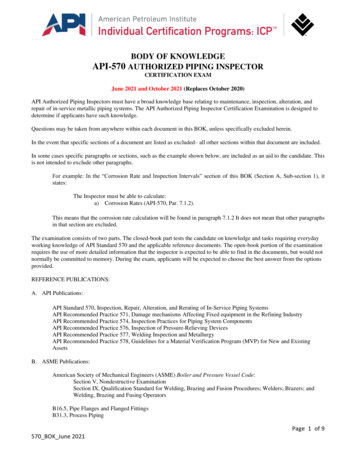
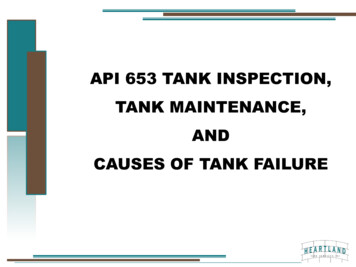
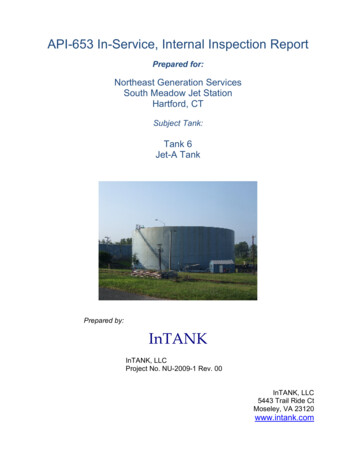
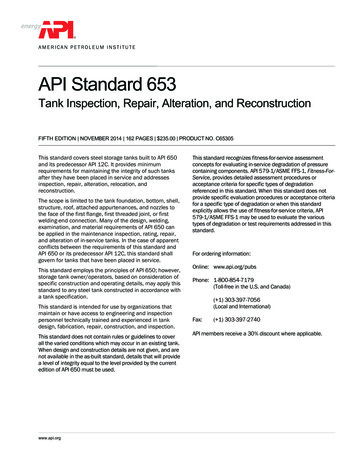
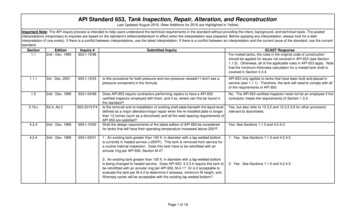
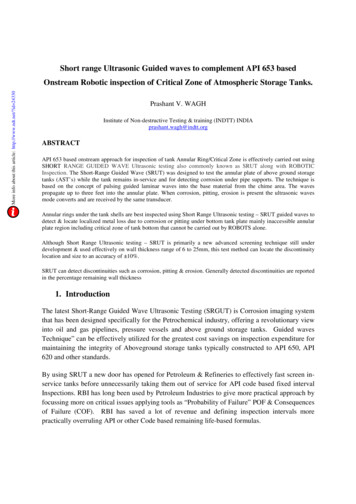
![API Ballot: [Ballot ID] – API 510 & API 570, Deferrals, Rev05](/img/5/api510andapi570deferralsrev5.jpg)
